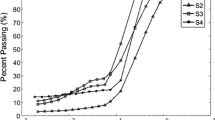Abstract
Previous porosity models have been shown to be unable to accurately describe the pore-size distribution of rocks and soils. Three new porosity models are developed in this study. Pore-size distributions of soft clay and ecotypic revetment material were obtained using a scanning electron microscope (SEM) in two-dimensional space, and with the mercury intrusion method in three-dimensional space. The results show that the new porosity models are valid in predicting the accumulative porosity of rock and soil samples. Based on the new porosity models, a new microstructure soil consolidation model was developed and the error of the compression strain prediction was less than 0.007 under low pressure. Several models for soil water retention curve were founded, which in form comprise previous models developed by other researchers, and they may be more accurate than previous models because of the valid mean for determining the fractal dimension. In addition, we obtain an expression for the relationship between soil cohesion and the test specimen size, as well as between the bulk density of rocks and soils and the test specimen size.
Similar content being viewed by others
References
Katz A J, Thompson A H. Fractal sandstone pores: Implications for conductivity and pore formation. Phys Rev Lett, 1985, 54: 1325–1328
Yu B M, Li J H. Some fractal characters of porous media. Fractals, 2001, 9: 365–372
Rieu M, Sposito G. Fractal fragmentation, soil porosity, and soil water properties: I. Theory. Soil Sci Soc Am J, 1991, 55: 1231–1238
Tao G L, Zhang J R. Two categories of fractal models of rock and soil expressing volume and size-distribution of pores and grains. Chinese Sci Bull, 2009, 54: 4458–4467
Rieu M, Sposito G. Fractal fragmentation, soil porosity, and soil water properties: II. Applications. Soil Sci Soc Am J, 1991, 55: 1239–1244
Perfect E, Kenst A B, Díaz-Zorita M, et al. Fractal analysis of soil water desorption data collected on disturbed samples with water activity meters. Soil Sci Soc Am J, 2004, 68: 1177–1184
Perfect E, Mclaughlin N B, Kay B D. An improved fractal equation for the soil water retention curve. Water Resour Res, 1996, 32: 281–287
Bird N R A, Perrier E, Rieu M. The water retention function for a model of soil structure with pore and solid fractal distributions. Eur J Soil Sci, 2000, 51: 55–63
Xu Y F, Dong P. Fractal models for the soil-water characteristics (in Chinese). Rock Soil Mech, 2002, 23: 400–405
Perrier E, Rieu M, Sposito G, et al. Models of the water retention curve for soils with a fractal pore size distribution. Water Resour Res, 1996, 32: 3025–3031
Yu B M. Advances of fractal analysis of transport properties for porous media (in Chinese). Adv Mech, 2003, 33: 333–346
Xu Y F, Huang Y C. Fractal-textured soils and their unsaturated mechanical properties (in Chinese). Chin J Geot Eng, 2006, 28: 635–638
Bonala M S, Reddi L N. Fractal representation of soil cohesion. J Geotech Geoenvir Engin, 1999, 125: 901–904
Roberts J N. Comment about fractal sandstone pores. Phys Rev Lett, 1986, 56: 2111
Feder J. Fractals. New York: Plenum Press, 1988
Yu B M. Comments on “fractal fragmentation, soil porosity, and soil water properties I. Theory”. Soil Sci Soc Am J, 2007, 71: 632
Sposito G. Response to “comments on’ fractal fragmentation, soil porosity, and soil water properties: I. Theory’”. Soil Sci Soc Am J, 2007, 71: 633
Zhang J R, Zhu J, Huang L, et al. Evolution of micro pore structure of soft clay and its fractal features under consolidation (in Chinese). J Hydr Engin, 2008, 39: 394–400
Zhang J R, Zhu J, Huang W J. IPP image technique used for quantitative analysis of soil microstructure (in Chinese). J Wuhan Univer Techn, 2008, 30: 80–83
Zhang J R, Huang L, Zhu J, et al. SEM analysis of soil pore and its fractal dimension on micro scale (in Chinese). Acta Ped Sin, 2008, 45: 22–30
Zhang J R, Liu Z D. Microstructure of a planting material consisting of nutrition-expansive perlitic-cement composites. J Wuhan Univer Techn-Mater Sci Ed, 2003, 18: 75–78
Zhang J R, Liu Y Z, Liu Z D. Quantitative analysis of micro-porosity of eco-material by using SEM technique. J Wuhan Univer Tech-Mater Sci Ed, 2004, 19: 35–37
Perfect E, Mclaughlin N B, Kay B D, et al. Reply. Water Resour Res, 1998, 34: 933–935
Garga K V. Effect of sample size on shear strength of basaltic residual soils. Can Geotech J, 1988, 25: 478–487
Lo K Y. The operational strength of fissured clays. Geotechnique, 1970, 20: 57–64
Tsur-lavie Y, Denkamp S A. Comparison of size effect for different types of strength tests. Rock Mech, 1982, 15: 243–254
Author information
Authors and Affiliations
Corresponding author
About this article
Cite this article
Zhang, J., Tao, G., Huang, L. et al. Porosity models for determining the pore-size distribution of rocks and soils and their applications. Chin. Sci. Bull. 55, 3960–3970 (2010). https://doi.org/10.1007/s11434-010-4111-6
Received:
Accepted:
Published:
Issue Date:
DOI: https://doi.org/10.1007/s11434-010-4111-6




